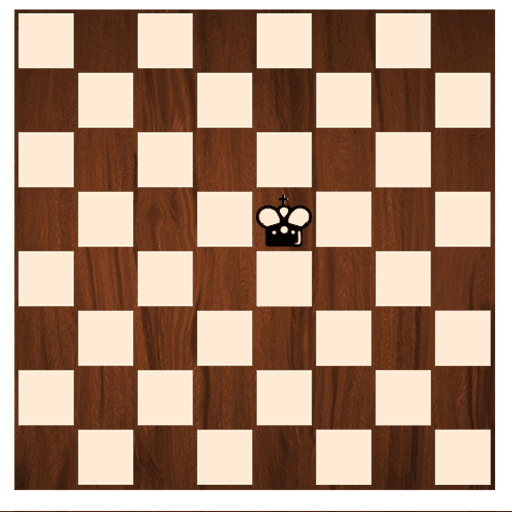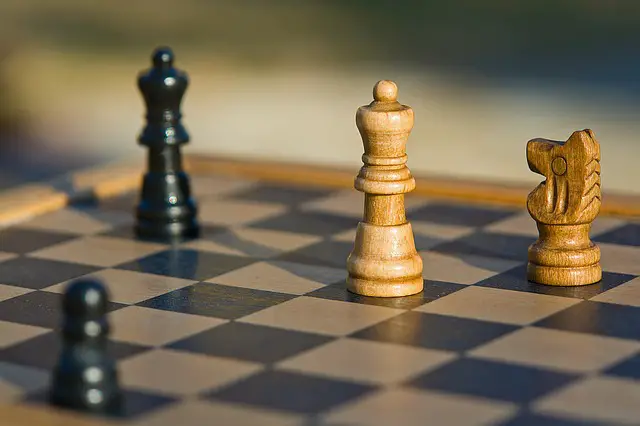No, under no circumstances can a king take another king. Firstly, it is an illegal chess move for two kings to be next to each other on a chessboard. It is, therefore, impossible for a king to take another king.
In this article, I’ll discuss all that you need to know about chess’ most important piece. Sure, the king can only move one square at a time, but the entire game is centered around this vital piece.
I will discuss how the king moves, how the king captures, and the importance of always keeping your king safe. In this article, I will also discuss other illegal chess moves to keep in mind and to avoid at all times.
So, without further ado, let’s get to know the powerful king!
Table of Contents
The Mighty King
The king taught me that capabilities and wealth (or the lack thereof) is not an indication of importance.
Let me explain.
When learning how to play chess, the king was never my favorite piece. It can only move one square at a time, not to mention all the other pieces that are so much cooler to use. The queen has more moves to her availability, and no one can maneuver quite like a knight.
Then why all the fuss about the king? Then, I realized that these pieces were powerful so that they can protect the king: the very reason that the game exists.
This made me think that maybe the king is powerful in other ways. Maybe it is a good and kind ruler that gives fair opportunities to all its subjects. Why else would the pieces risk their lives for the king?
Of course, this was only the reasoning of a child with a wild imagination, trying to put a story behind every piece on the board. But even today, the king reminds me to treat everyone equally, no matter their capabilities.
Meet the Army Commander
It is our job in chess to protect our king at all cost. We must protect it from being captured by opponents, and try to capture the other king.
A king is ultimately how you win a game, or how you lose a game.
The king is always the tallest piece on the chess board, usually with a little cross on its head.
How Does the King Move?
The king can only move one square at a time. I like to think of the king as an old man, hobbling around his kingdom very slowly.
The king can move in any direction, as long as it is one step at a time.

For example, a king on C3 can move upwards to C4, sideways to either B3 or D3, diagonally to B4 or D4, backwards to C2, or backwards diagonally to B2 or D2.
Thus, if no opponents are in a king’s way, it has the option to move in a variety of eight ways.
Do king’s moves have to follow each other?
No, a king can move one way on its first move, and another on its second.
For example, if a king on F7 is trying to get to G5, it can move downwards to F6 on its first move and diagonally to G5 on its second move.
How Does the King Capture?
The king captures in the same way that it moves; one step at a time in any direction.
A king must, of course, do so without placing itself in danger of capture. For example, if an enemy rook is on D8 and F7, and your king is on E6, the king can capture the rook on F7. The king must not move one step forward in an attempt to capture D8’s rook, as this would mean placing itself in check by the rook on F7.
Never Put Your King in Danger
As the commander of your army, the king must never be put in danger. It is your job, and the entire purpose of the game, to protect you king at all cost.
Therefore, you must never put your king on a square that an enemy piece is aiming towards. In fact, it’s illegal to do so. For example, if an enemy rook is on D8, you cannot place your king on any square in this rook’s attack zone.
For this reason, it is crucial to carefully inspect the chess board (or battleground) before moving your king. You need to consider all the possible moves that other pieces can make, to ensure that your king is not in danger.
Any moves that put your king in direct danger are considered as illegal moves.
What if my opponent makes an illegal move with their king?
The rules of chess state that you cannot put your king in direct danger. In other words, you cannot move your king into check.
So what happens if your opponent — by accident — places their king directly in front of your piece’s firing zone? Do you say nothing and capture your opponent’s king on the next move?
No, placing your own king in direct danger is considered an illegal chess move. It is, therefore, appropriate to politely inform your opponent that they cannot move their king into danger. Your opponent then has the opportunity to re-do their move to a safe zone.
What if there is nowhere safe to move my king?
As mentioned above, it is considered an illegal chess move to move your own king into danger — or check’s — way.
So, what happens if you have exhausted all the possible moves to keep your king safe? If your king can no longer move to safety, it is in checkmate. This symbolizes the end of the game, meaning you have unfortunately lost.
Checkmate can occur when your king is attacked from all possible sides, leaving it nowhere to go. This also means that you likely have no other pieces left, or that they are unable to assist the king.
Always remember that the king is the most important piece on the board. Every move you make, should be an attempt to protect your king. Of course, you must also attempt to attack your opponent’s king.
However, you must also protect your king at all costs.
Can a King Take a King?
Under no circumstances can a king take another king. This is an impossible move to make, as it is an illegal chess move for two kings to be directly next to each other on the chessboard.
So what happens if an opponent places their king next to mine? In an informal game and casual game, it would be appropriate to inform your opponent of the mistake that they have made. They then have the opportunity to re-do their move.
In a formal game, such as those seen between grand masters and in tournaments, the arbiter (like an umpire in chess) will have to be called. They will then have to put extra time on the clocks for a move to be redone.
Other Illegal Chess Moves
Interested in learning more about illegal chess moves? Here are a few to keep in mind and to avoid.
A king can not stay in check
When a king finds itself in check, it is imperative to get out of this dangerous position. A king must safely move to a square where they are no longer in chess.
Does this mean that your king can move as many times as they want to get out of chess? No. A king must safely move out of check within one move.
Another way to get your king out of chess is to move a different chess piece in front of their path towards your king. This way, your king will no longer be in chess.
Or you can capture the piece that put your king in check.
If you have exhausted all the possible ways to keep your king out of chess, you are in checkmate. This indicates the end of the game, and your opponent wins.
A king cannot move into check
Just as a king cannot remain in check, it also cannot move into check.
The bottom line of chess is always to protect your king. If your king is in check, you cannot move it into a different space where it is also in check.
A king may never be next to a king
You now know that a king can never place itself in danger. For this reason, the rule also exists that two kings may never be directly next to each other on the chessboard.
This means they cannot be in contact vertically or diagonally.
Why? Well, think about it. If you move your king next to your opponent’s king, your king is in check. Think of it this way: the kings are so powerful that they must never meet, or the chessboard will implode.
A king cannot capture a guarded piece
As you know, a king must never place itself in danger.
For this reason, it is also illegal for a king to capture an opponent’s piece that is guarded.
For example, your king cannot capture an enemy pawn that is backed by an enemy rook. Once you capture the pawn, your king will automatically be in check from the rook.
A piece keeping the king out of check cannot move
Let’s say a rook is protecting your king from being captured by an enemy piece. Now, you see a valuable piece in the rook’s firing zone, so you decide to take your chance.
Only, you can’t do this! By moving the rook, your king will be back in check. The only time you can move a piece that is protecting the king, is when you move another one of your pieces to keep your king out of chess.
The aim of the game is, after all, to keep your king protected at all times.
Conclusion
In this article, we learned that a king can never take another king in chess. Not only is this move illegal, but it is also impossible to achieve. Why? Because two kings are never allowed to be next to each other on the board.
We also discussed other illegal chess moves, such as placing your own king in check, or using your king to capture a guarded piece.
Use what you’ve learned today and remember: always protect your battalion’s commander!

Veronica is a Green Bay-based freelance writer and editor with extensive experience with board games. When not busy scribbling her thoughts, you might find her in her garden, hiking out in the woods, or exploring new food joints.
Veronica is a die-hard board game and chess hobbyist by night. She likes to try out new games and is always on the lookout to recruit new players for her game night (so beware!). When not playing board games or throwing darts, she is usually busy painting miniatures (or doing other nerdy stuff).
She is the CEO & Content Writer of Indoor Games Zone. She shares her expertise from years of playing chess, board games, and darts.

![Stiga XTR Pro Review | 1,559+ Global Ratings (In-Depth Guide) [year] Stiga XTR Pro Review](https://indoorgameszone.com/wp-content/uploads/2021/08/Stiga-XTR-Pro-Review-218x150.jpg)





